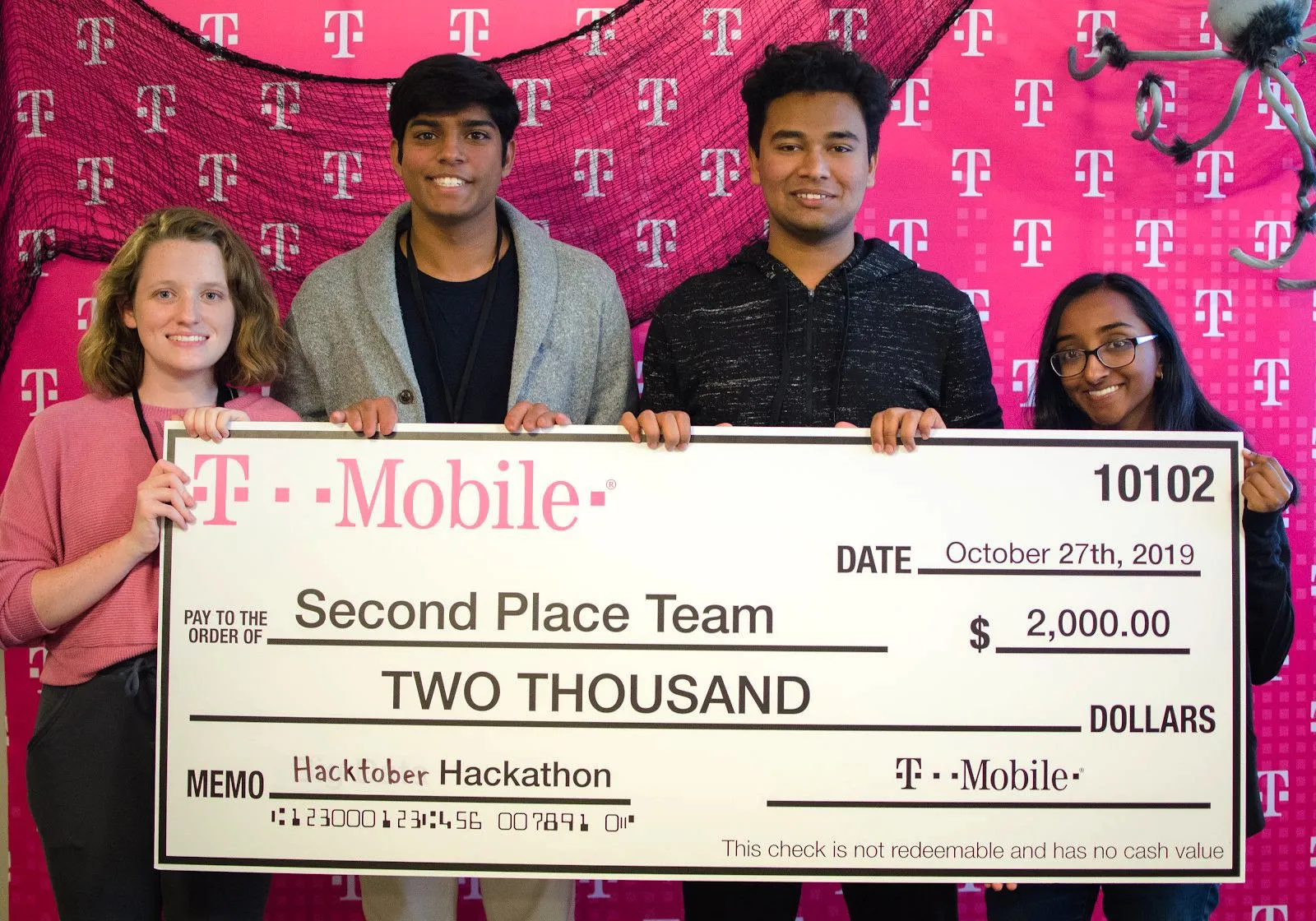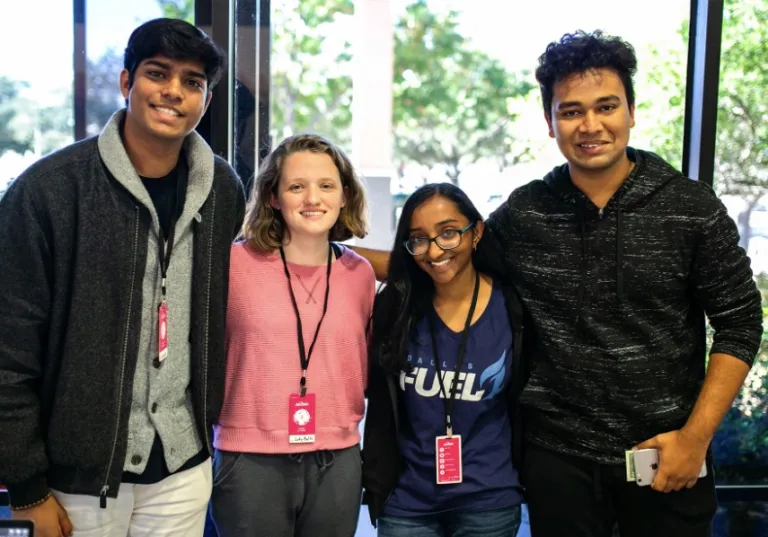Student Hackathon Experience: All Freshmen Team Win 2nd Place at T-Mobile Hacktober Hackathon

A freshman CS team at UT Dallas consisting of Supratik Pochampally, Khalid Hossain, Cady Baltz, and Christina Abraham recently competed in the T-Mobile Hacktober Hackathon and finished in 2nd place. Below is a short story written by Supratik Pochampally about his time participating in the T-Mobile Hacktober Hackathon and why he believes hackathons are important for students to attend.
Hackathons are fun, rewarding events that allow participants the opportunity to expand their skill sets, gain experiences, and share knowledge by working on a collaborative tech-related project designed to solve a problem. They allow people of various backgrounds to meet others who share the same passions, boost their resumes, and learn to finish projects in a limited time frame. There are many breeds of hackathons with varying time limits, restrictions, and themes, with some offering scholarships and cash prizes for the winners.
UT Dallas hosts a plethora of on-campus hackathons with a wide range of themes, topics, and scales of projects. The T-Mobile Hacktober Hackathon gave us a unique set of topics and guidelines for us to follow while developing an app. This hackathon was focused on Extended Reality (XR), a blanket term that covers Augmented Reality (AR) and Virtual Reality (VR) technology. Our objective was to design and create a solution incorporating elements of AR to a problem relating to T-Mobile’s Metro brand. With this goal in mind, we set out to produce a consumer solution that decreased the online return rate of products while promoting brand engagement.
The greatest challenge we faced was coming up with an idea for our product. My team and I spent weeks leading up to the event brainstorming a creative new product we could design that incorporated XR, while still falling within the guidelines set by the event. We started by pursuing the more obvious applications of XR technology, such as a scavenger hunt or video game. We realized, however, that many of the other teams would be doing similar, if not identical, projects. Our goal was to make an exciting new application that stood out to the judges as well as our audience from amongst a crowd of participants. Unfortunately, because of this mindset, every idea we came up with was either too basic to stand out or too advanced for us to create with our limited time and skills. That’s when we received a spark of inspiration by a T-Mobile employee, who pointed out a very elucidating statistic: the number one reason why consumers are dissatisfied with the phones they purchase online is that they misjudge its size from photos, and find it either larger or smaller than expected. This inspired us to create an AR application which, using a dollar bill as a reference, projects a life-size model of the phone one is viewing into a customer’s hand. This allows the user to get a grasp of the size of the phone before buying it.

Hackathons admittedly have one of the most challenging environments within which to work, given the limited time frame and the need to quickly develop ideas. That being said, we strongly recommend that anyone pursuing a career involving computer science or information technology take part in at least one sometime early in their education. With only 24 hours, we learned to partition time, prioritize key elements of our project, and compromise on what we could get done. We did code-sprints of about five hours each, taking short breaks in between and attending workshops hosted by T-Mobile in order to fill in gaps in our abilities. None of us had ever designed a product using AR before, so the workshops were extremely helpful and provided us with the opportunity to learn the skills we needed to finish our project.
Furthermore, there was a massive element of self-teaching through the development process. We learned how to implement Apple’s ARKit with Swift and how to scale each model of the phones on top of the dollar within SketchUp 3D and xCode. I found it helpful to give little “mini-pitches” of what we had completed so far to some of the T-Mobile employees and representatives throughout the building process, so they could provide us with feedback and comment on what we ought to improve. After the product was completed and we had a working demo, we had to present it to the judges. The first stage was an expo style setup—similar to a science fair—where we set up our demo and showed it off to people walking around. We then qualified for the finals, where we had to pitch our product to a board of judges. We aimed to make our presentation as engaging with the audience as possible, keeping a positive tone throughout the pitch, and answering the judge’s questions with in-depth responses.
In the end, we finished in 2nd place and won $2,000, which was split between the four members of our team. Completing the hackathon was one of the most rewarding and gratifying moments of my life; I got to witness 24 hours of non-stop work culminate in a completed project. Getting the opportunity to problem solve and work towards an actual physical product with a time pressure on my shoulders taught me so much about programming in the real world; I feel like I learned more in those few hours than I have in whole weeks of some classes. I would highly recommend attending a hackathon to anyone who wants a chance to learn in an intense, adrenaline-high environment, and come out with a completed project. And if for no other reason, go for the learning workshops, special events, and the free t-shirts!
If you are interested, be sure to check out our project.
Supratik Pochampally is a freshman CS student at UT Dallas. His main interests are Artificial Intelligence and Prosthetic Engineering. He is planning to pursue a career in management. In his free time, he enjoys playing the trumpet and doing origami.
ABOUT THE UT DALLAS COMPUTER SCIENCE DEPARTMENT
The UT Dallas Computer Science program is one of the largest Computer Science departments in the United States with over 3,315 bachelors-degree students, more than 1,110 master’s students, 165 Ph.D. students, 52 tenure-track faculty members, and 44 full-time senior lecturers, as of Fall 2019. With The University of Texas at Dallas’ unique history of starting as a graduate institution first, the CS Department is built on a legacy of valuing innovative research and providing advanced training for software engineers and computer scientists.




